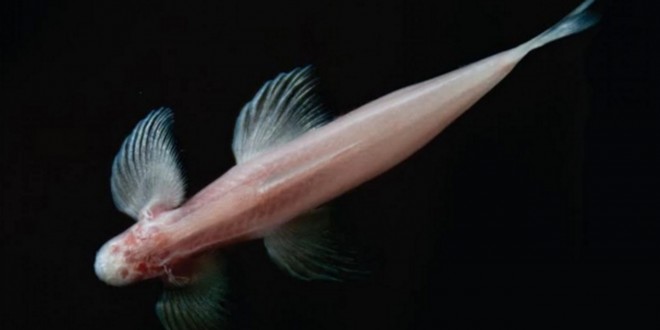Known as the Cryptotora thamicola, the blind fish boasts the ability to use its limbs for walking and can actually climb up a waterfall!.
Researchers from the New Jersey Institute of Technology have identified the walking cavefish, a fish that can walk on land and even climb waterfalls using its salamander-like limbs in the same way as a tetrapod, or a four-footed mammal or amphibian. So far, no other fish has been found with these anatomical features.
“The pelvis and vertebral column of this fish allow it to support its body weight against gravity and provide large sites for muscle attachment for walking,” Brooke E. Flammang, co-author of a new Scientific Reports paper about the creature and an assistant professor of biological sciences at NJIT, explained in a statement.
Flammang told the Washington Post that she first saw the pink-colored fish in footage collected by her co-author, also an assistant professor in the NJIT Department of Biological Sciences and was stunned by what the paper refers to as the “salamader-esque wiggle” of the creature.
As she and her colleagues explained in their study, the cavefish travels using a diagonal-couplets style, lateral sequence gait similar to the aforementioned amphibians, and has pelvic bones which are comprised of a broad puboischiadic plate linked to the iliac process of a hypertrophied sacral rib, instead of having suspended or loosely-attached bones nearly all other species of fish.
Furthermore, Cryptotora thamicola has large anterior and posterior zygapophyses, transverse processes, and broad neural spines in the vertebral column of its sacral area – features that are all closely associated with terrestrial organisms, the study authors wrote. It pulls off its odd gait by rotating its pectoral and pelvic girdles to create a wave-like motion of its axial body. The authors call it the first ever example of tetrapod-like walking behavior and morphology observed in an extant fish.
“This research gives us insight into the plasticity of the fish body plan and the convergent morphological features that were seen in the evolution of tetrapods,” Flamming said, telling Discovery News, “From an evolutionary perspective, this is a huge finding. This is one of the first fish that we have as a living species that acts in a way that we think they must have acted when they evolved from a fluid environment to a terrestrial environment.”
Agencies/Canadajournal
 Canada Journal – News of the World Articles and videos to bring you the biggest Canadian news stories from across the country every day
Canada Journal – News of the World Articles and videos to bring you the biggest Canadian news stories from across the country every day



